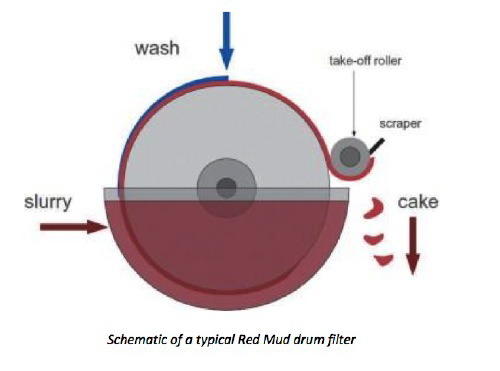For a pdf version of the description please see here. For the final report please see here.
Introduction
Aughinish Alumina (AAL) extracts Alumina from Bauxite using the Bayer process which results in the generation of bauxite residue. This bauxite reside is separated from the Alumina-rich process stream before it is sent to the Bauxite Residue Disposal Area (BRDA). The method of storage of bauxite residue is that of a dry stack which requires a high solids content. This is achieved through filtration. As part of the filtration step the mud is also washed to recover caustic before it is sent to the Bauxite Residue Disposal Area.
Background
The mud filtration area features 8 similar but not identical drum filters. The number of filters on line at any one time depends on the mud load but there is an allowance for one filter to be off for maintenance or re-clothing. The filters are fed slurry of typically 40% solids. An automated control valve maintains a level in the filter trough. The speed of each filter is also regulated by a variable speed drive. Each rotary drum filter is divided into cells or sections with the whole drum covered by a filter cloth and a backing cloth. Under vacuum and in the submerged trough, solids are deposited uniformly over the outer surface of the drum. A take- off roller strips the bauxite residue from the filter and the residue is then combed from the roller.
The capacity of these filters depends on factors such as but not limited to the filtration media condition, rotation speed, fouling, vacuum and wash flow.
The mud filters are taken offline every morning for washing. In general 2 filters are taken off at a time and it takes 60-120mins to wash them. The mud filters are also caustic washed every 6 weeks for approx. 12hrs. When a filter is on caustic wash it also utilises the same vacuum, reducing the capacity of the online filters.
Existing Situation
Recent developments in the area have led to the introduction of a simple online capacity calculation which has helped to optimise the area. The online calculation looks at the performance over the previous 10mins and uses this to predict a filter capacity. An online control scheme utilises this calculated capacity to balance the flow across the available filters and maximise the wash.
Challenge
Mud filtration is very dynamic area and rarely in steady state. Over a typical 24hr period the area will go from times of being filtration capacity limited to having excess capacity.
It would be beneficial to be able to,
- Predict and plan the capacity of the area over a 24 hr period.
- Maximise the average wash per filter over a 24 hr period.
Ideally, this would then be integrated into an online control scheme.








